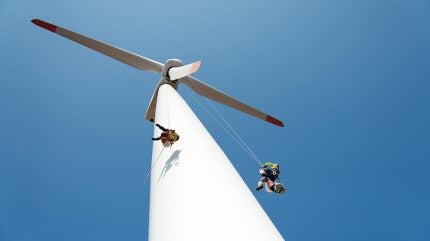
The G9 Offshore Wind Health and Safety Association was established in 2010 by nine founding members – Centrica, DONG Energy, E.ON, RWE Innogy, Scottish Power Renewables, SSE, Statkraft, Statoil and Vattenfall – its sole aim being to put health and safety at the forefront of the offshore wind industry.
To strengthen this commitment, the G9, in conjunction with the Energy Institute, released its first-ever annual incident report this year. The report comprises 2013 incident data from 35 G9 members’ business sites across Northern Europe, therefore providing a previously unseen snapshot of health and safety incidents in the offshore wind industry in a particular geographical location.
G9 chairman, Benj Sykes, has said he hopes the annual report will become a ‘tool’ to document the evolution and improvements of health and safety in the sector.
“There is still work to be done but I am confident with the help and commitment of my fellow G9 members and the wider offshore wind business community we can work together to make this industry a safer place to operate,” Sykes added.
Lost work day incidents: 66
A lost work day incident is defined as a “non-fatal incident that involves a person being unfit to perform any work on any day after the occurrence of the occupational injury”. Of the 66 lost work day incidents recorded, four were reported under RIDDOR (Reporting of Injuries, Diseases and Dangerous Occurrences Regulations), which requires occupational diseases and, among other things, specific injuries, such as fractures, amputations, loss of consciousness or crushing, to be reported. The report doesn’t specify what these incidents were or how many work days were lost.
The report reveals that 44% (32) of the lost work day incidents occurred on vessels. Eighteen (27%) lost work day incidents occurred during manual handling activities – ten of these on vessels. Nine incidents involved lifting operations, five of which were on vessels. Six incidents happened while operating plant and machinery, and eight during marine operations
Lifting incidents: 165
Lifting represents the work process with the most incidents recorded. In total, lifting operations were responsible for nine lost work day incidents, 20 incidents that required first aid and 108 near hits – defined as an “incident which could have resulted in a work related accident but did not, either by chance or timely intervention”.
Lifting operations on vessels proved the most precarious, with 63% of all incidents involving these scenarios. After vessels, incidents occurred mostly at harbour, quay and pontoon (12%), then at the transition piece area (8%). Based on incident data collected between 2011 and 2012 by G9 and the Energy Institute, lifting operations are identified as one of the top three areas of highest risk in regards to health and safety, so these figure come as no surprise.
Working at height incidents: 45
Working at height, along with marine operations, was also identified as one of the top three highest health and safety risks by the G9 and Energy Institute. Thirty-one percent of working at height incidents occurred in the turbine tower itself, with 16% occurring around the hub and blades and 13% on the met masts.
Of the 45 incidents occurred, 36 involved near hits, one was a lost work day incident and four required first aid. Four were classified as hazards – defined as “a condition or a situation where there is a potential to cause an incident”.

Marine operations incidents: 131
The last category identified as a higher risk area is marine operations. This includes maritime operations, transfer by vessel, vessel mobilisation and vessel operations. Of the 131 marine operation incidents to occur, 84 happened on operational sites and 47 on project sites.
Most of the recorded incidents happened on vessels themselves – 106 in total. Marine operations resulted in four near hits, 31 hazards, 8 lost work days incidents, ten incidents requiring first aid, seven incidents categorised as medical treatment injuries (MTI0 – defined as “non-fatal incidents that involve a person being unfit to perform any work on any day after the occurrence of the occupational injury”.
Incidents on project sites: 243
According to the report, throughout 2013 incidents were classified as occurring in either project or operation sites. Project site is defined as “all states of the project – development construction, commissioning”.
Overall, there were 243 incidents on project sites, including 148 near hits, 39 lost work day incidents, 22 requiring first aid, five resulting in restricted work days (RWD – defined as an “incident that does not result in a fatality or a lost work day but does result in a person being unfit for the full performance of the regular job” – and 14 MTI.
Forty-five of the 243 incidents occurred during lifting operations, 21 working at height and 19 during manual handling.
Incidents on operational sites: 373
Operational sites are defined as “sites in operation producing power”. In total, 373 incidences occurred in operational sites. These include 193 near hit incidents, 39 requiring first aid, 26 classified as lost work day incidents, 92 hazard incidents, 15 MTI incidents and seven RWD incidents.
The majority of operation site incidents, 120, occurred during lifting operations, with 44 occurring during transfer to vessel, the third highest incident category being “other” and the fourth during vessel operation. Of these incidents, 165 occurred on vessels, 32 on the nacelle and 26 on the turbine tower.
Incident Areas: 32
The majority of health and safety incidents occurred on vessels – 281 in total. This can be broken down to 199 occurring on unclassified vessels, 46 on large vessels and 36 on small vessels. These incidents add up to 32 lost work day incidents, eleven MTI and eight RWD incidents, 31 incidents requiring first aid, 50 hazard incidents and 149 near misses.
Forty-four incidents happened on the turbine tower, 40 on the nacelle, 43 at harbour, quay and pontoons and twelve on the access ladders. Surprisingly, 22 incidents occurred in an office area.


.gif)

